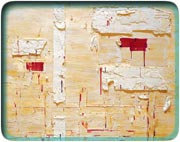






Also this issue: "4 Artists of Distinction" Le Ballet National du Senegal Beatlemania Now Project Dealer's Choice Donna Uchizono Co. In the Shape of a Spider Georgian State Dance Company Lucia di Lammermoor |
|||||||||
November 14-20, 2002
art
Wlodzimierz Ksiazek: New Paintings
 Wlodzimierz Ksiazek, Untitled (2002), 79 inches by 90 inches, oil on canvas. |
This small but forceful exhibition at the Art Alliance presents six new paintings by Wlodzimierz Ksiazek (pronounced shawnshek), a politically active Polish artist who has lived in the U.S. since fleeing martial law in 1982. The paintings offer huge fields of paint rigorously treated with small events: scratches, gouges, scabs that have been picked at. Their stark concreteness relates to certain abstract paintings (I think of Franz Kline, Antoni Tapies and Anselm Keifer) that have the actions of the artist recorded in pure form and pigment.
My first impression of Ksiazek's paintings, seen from a distance, was of their profound emptiness and silence. All of the paintings are untitled and are distinguished only by their dates and dimensions. This feature serves to heighten their identity as ordinary objects in the world, possessing no meaning other than their physical attributes. If it's true that, as someone once told me, the title is the light that the artist holds up to illuminate the work for the viewer, then these untitled paintings are intended to be experienced in the dark, without the aid of language, like a wall we bump into on our way to somewhere else.
But within their mute walls of paint, there are metaphors hidden. And it is the work of each viewer to travel along the surface and dig up meaning. I began to see Ksiazek's paintings as vast fields of earth, alternately fertile or barren, in which the artist works with paint: plowing, leveling, scraping, digging and piling. Up close, the precise dramas of their material qualities and physicality offer lots of little surprises and even, here and there, a hidden voluptuousness. One big painting, Untitled, 2002 (78 inches by 90 inches) is made from massive quantities of Naples yellow oil paint, and its whole surface has been plastered with textured slabs of paint, angular exfoliated sections and additions to the surface such as irregular rectangles of reapplied, dried paint and a few dabs and splatters of red paint. One particularly thick area of paint reminded me of a frosted sheet cake with a lick out of it.
Another large painting, Untitled, 2002 (49 inches by 60 inches) presents a monochromatic field of blue. It appears to be an unpleasantly cloying shade of baby blue, but after standing in front of it for a while I noticed that the color has been subtly neutralized by its opposite, pushing it slightly into a minor chord. Other effects, such as thick areas of paint scraped down to bare canvas and showing pieces of letters (useless fragments of language), a wet blue wash and thick areas of impasto with smooshed and troubled surfaces -- perhaps the imprint of a kiss -- add to the physical complexity of the encounter.
The small paintings in the exhibition are just as monumental in their scope, beautifully evoking space and landscapes. In the oil and encaustic on panel painting, Untitled, 2002 (12 inches by 16 inches), Ksiazek manipulates a restricted palette of dirty white, gray and pale blue. This abstract surface obliquely suggests a vast landscape: a grimy urban scene or dirty snow-covered fields, tire tracks, muddy water and patches of reflected sky. In another small painting, Untitled, 2002 (30 inches by 34 inches), the artist has incised marks -- like receding lines in a perspective drawing -- into a field of ivory paint that create a serenely classical place. Nestled into this framework, little bits and dabs of deep red-violet and pinkish-orange paint, like glimpses of the setting sun or magma within the earth, add to the intensity of the physical sensations more audaciously than any other piece.
Ksiazek's paintings have provoked a lot of extremely interesting critical writing, which may, in truth, be an unnecessary prop to the paintings' silent eloquence as real objects. At their core these are purely physical, dumb, soundless paintings -- blank slates (almost) to which we can bring our own experiences and sense of physicality. These six paintings offer great rewards to the patient viewer.






